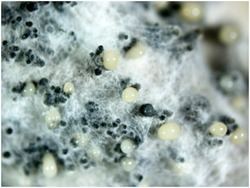Kingdom Fungi Rank Species Subclass Sordariomycetidae | ||
 | ||
Similar Phomopsis, Diaporthe phaseolorum, Diaporthe, Diaporthe phaseolorum var sojae, Aspergillus sojae | ||
Phomopsis longicolla is a species of ascomycota fungi in the Diaporthaceae family. It is a plant pathogen and mainly responsible for a soybean disease called Phomopsis seed decay (PSD). In other plant species, P. longicolla can also live as an endophyte, such as in the mangrove plant Sonneratia caseolaris. P. longicolla has also been found to produce a number of cytotoxic and antimicrobial secondary metabolites, such as dicerandrols and phomoxanthones. P. longicolla was first described in 1985 by Thomas W. Hobbs et al. at the Department of Plant Pathology at Ohio State University
References
Phomopsis longicolla Wikipedia(Text) CC BY-SA
